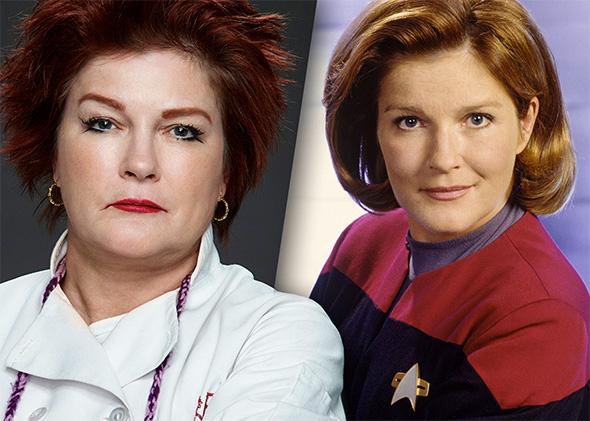It may be hard to imagine Kate Mulgrew as anyone other than Red, the tough-as-nails Russian cook on Orange Is the New Black. But for certain viewers—those who occupy the surprisingly crowded middle of a Venn diagram containing OITNB fans and Star Trek fans—she is both Red and Captain Kathryn Janeway of the USS Voyager. And in fact, the two shows have more in common than just Mulgrew. I’d go so far as to say that Orange Is the New Black is the new Star Trek.
Captain Janeway and Galina Reznikov do share a raft of traits: They are wry, competent, honorable, in charge. They are loyal to their devoted crews, smart and enterprising—whether problem-solving in space or masterminding the stream of contraband in and out of Litchfield—and flinty when necessary. (Janeway sometimes demonstrates her badassery by exploding things, whereas Red prefers to stow a tampon in the enemy’s sandwich.) Both are lifted out of their normal lives and deposited far from home—Janeway in the distant Delta Quadrant, Red in a low security women’s prison—where they must forge new, unconventional families.
But for all the echoes between the two characters, it’s really the shows themselves that are in dialogue. Star Trek and Orange Is the New Black both feature ensemble casts thrown into close quarters, where they wear uniforms, manage power hierarchies, and are bound by rules explicit and unspoken. The shows espouse a vision of ethnic diversity and social progressivism. They underscore the challenges and complications of coexistence—the tectonic shifts of alliance and betrayal, the negotiation of difference—and yet neither one is willing to give up on its overall inclusive goal.
Star Trek set out in the late ’60s to explore new worlds, applying the same spirit of humanistic discovery to vistas literal and metaphorical. Starfleet members illuminated dark corners of the universe, sure, but they also opened up a multicultural space where motley individuals could come together under a common purpose. In bringing viewers inside a women’s prison, OITNB similarly treads “where no man has gone before,” lifting the veil on an uncharted ecosystem, and approaching the unknown with openness and empathy rather than scorn.
I won’t deny that the shows diverge, at least superficially, in tone. The year 2015 is a lot more cynical than 1995, when Star Trek: Voyager launched and scientific wonder could be solemnly expressed outside of Christopher Nolan movies. The space travel franchise looks shiny and utopian, while OITNB takes disenchanted realism to the point of showers that spit sewage. Plus, the inmates themselves, fiercely segregated into white, black, and Hispanic factions, don’t seem especially tolerant or enlightened. (Red: “Black girls know about chicken, of course they’ll chase it.” Piper: “Why? Cause all black people like chicken?” Red: “Don’t be racist—it’s because they’re all on heroin.”)
But OITNB, qua show, pays an unprecedented amount of respectful attention to women at the margins, just as Star Trek was notable for its embrace of Russian, Japanese, and black American protagonists. (Also alien ones.) Star Trek gave Uhura—played by Nichelle Nichols, whose name totally inspired the character Nicky Nichols, right?—a textured realization at a time when most black actresses were cast as maids. Likewise, Orange Is the New Black spins intimate, nuanced narratives around, for starters, transpeople, butch lesbians, non-butch lesbians, older women, poor women, and overweight women. These characters are presented not as peripheral or supporting but as the heart of the matter—their stories are the story, end of story.
Compare Orange Is the New Black’s clear-eyed, humanistic, often funny depiction of gay eros with Star Trek, which shocked audiences in 1968 by portraying one of television’s first interracial kisses. Or consider creator Gene Roddenberry’s intent to “make statements about sex, religion, Vietnam, politics, and intercontinental missiles” with his show, to use the interstellar adventures as morality tales, in light of OITNB’s clear agenda: prison reform (see the Fig corruption plot), a working social safety net, less discrimination and prejudice.
Indeed, it’s in the disavowal of stereotypes—the close, generous look at who characters really are—that Orange Is the New Black makes its subtlest contact with Star Trek. Roddenberry’s show ended up endorsing pluralistic rationalism: commitment to reason, regardless of one’s worldview. The Vulcan crewmember Spock in particular became the mouthpiece for dispassionate logic; he belonged to a peace-loving race whose philosophy was based in the acronym IDIC, for “infinite diversity in infinite combination.” When you get right down to it, isn’t Star Trek’s appeal to reason and empiricism kind of the same as OITNB’s rejection of preconceived notions? Or put more strongly: Isn’t Orange Is the New Black’s insistence that we reconsider our biases tantamount to a Vulcan logical imperative?
Mulgrew’s Red happens to be an ambassador for logic in her own mordant way. “If you want to assassinate someone,” she points out, “vision is a basic requirement. It’s like, step one: Pick a person to kill. Step 2: Kill the right person.” That’s a sensible, Spock-like observation dressed up in modern-day irony, but the gist of Red’s arc in season 2 is that she’s no killer. She’s a leader, a fighter, and a caretaker rolled into one hardy package—in short, a fit captain for one of television’s most intriguing voyages yet.
